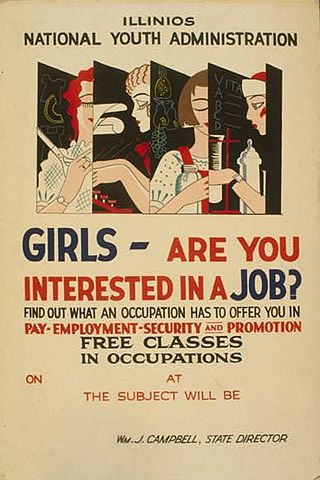
The Works Progress Administration was an American New Deal agency that employed millions of jobseekers to carry out public works projects, including the construction of public buildings and roads. It was set up on May 6, 1935, by presidential order, as a key part of the Second New Deal.

Greenbelt is a city in Prince George's County, Maryland, United States, and a suburb of Washington, D.C. At the 2020 census, the population was 24,921.

Ben Shahn was an American artist. He is best known for his works of social realism, his left-wing political views, and his series of lectures published as The Shape of Content.

Roy Emerson Stryker was an American economist, government official, and photographer. He headed the Information Division of the Farm Security Administration (FSA) during the Great Depression, and launched the documentary photography program of the FSA. It hired photographers to travel across the United States and document people in different areas and settings as part of showing the state of people in rural areas in those years. Specific projects were conceived to help assess effects of government programs.

The Federal Emergency Relief Administration (FERA) was a program established by President Franklin D. Roosevelt in 1933, building on the Herbert Hoover administration's Emergency Relief and Construction Act. It was replaced in 1935 by the Works Progress Administration (WPA).

The Farm Security Administration (FSA) was a New Deal agency created in 1937 to combat rural poverty during the Great Depression in the United States. It succeeded the Resettlement Administration (1935–1937).

Rexford Guy Tugwell was an American economist who became part of Franklin D. Roosevelt's first "Brain Trust", a group of Columbia University academics who helped develop policy recommendations leading up to Roosevelt's New Deal. Tugwell served in FDR's administration until he was forced out in 1936. He was a specialist on planning and believed the government should have large-scale plans to move the economy out of the Great Depression because private businesses were too frozen in place to do the job. He helped design the New Deal farm program and the Resettlement Administration that moved subsistence farmers into small rented farms under close supervision. His ideas on suburban planning resulted in the construction of Greenbelt, Maryland, with low-cost rents for relief families. He was denounced by conservatives for advocating state-directed economic planning to overcome the Great Depression.

Arthurdale is an unincorporated community in Preston County, West Virginia, United States. It was built in 1933 at the height of the Great Depression as a social experiment to provide opportunities for unemployed local miners and farmers. Arthurdale was undertaken by the short-lived Subsistence Homesteads Division and with the personal involvement of First Lady Eleanor Roosevelt, who used her influence to win government approval for the scheme.

Arthur Rothstein was an American photographer. Rothstein is recognized as one of America's premier photojournalists. During a career that spanned five decades, he provoked, entertained and informed the American people.

The National Youth Administration (NYA) was a New Deal agency sponsored by Franklin D. Roosevelt during his presidency. It focused on providing work and education for Americans between the ages of 16 and 25. It operated from June 26, 1935 to 1939 as part of the Works Progress Administration (WPA) and included a Division of Negro Affairs headed by Mary McLeod Bethune who worked at the agency from 1936 to 1943. Following the passage of the Reorganization Act of 1939, the NYA was transferred from the WPA to the Federal Security Agency. In 1942, the NYA was transferred to the War Manpower Commission (WMC). The NYA was discontinued in 1943.

The Puerto Rico Reconstruction Administration (PRRA) was one of the alphabet agencies of the New Deal established by the administration of President Franklin Delano Roosevelt. Created on May 28, 1935, the PRRA's first directors included American journalist and politician Ernest Gruening and Puerto Rican educator and politician Carlos Chardón. Falling under the authority of the Department of the Interior and the Farm Security Administration (FSA) its primary goals were to establish long term economic stability in Puerto Rico during the Great Depression through job creation, land distribution, public works projects, as well as environmental and health initiatives. The agency was officially liquidated on February 15, 1955.

George Nelson Peek was an American agricultural economist, business executive, and civil servant. He was the first administrator of the Agricultural Adjustment Administration (AAA) and the first president of the two banks that would become the Export-Import Bank of the United States.

Norvelt is a census-designated place in Mount Pleasant Township, Westmoreland County, Pennsylvania, United States, founded in 1934 as Westmoreland Homesteads. In 1937 it was renamed to honor Eleanor Roosevelt. The community was part of the Calumet-Norvelt CDP for the 2000 census, but was split into the two separate communities of Calumet and Norvelt for the 2010 census. Calumet was a typical company town, locally referred to as a "patch" or "patch town", built by a single company to house coal miners as cheaply as possible. On the other hand, Norvelt was created during the Great Depression by the federal government of the United States as a model community, intended to increase the standard of living of laid-off coal miners. Award winning writer Jack Gantos was born in the village and wrote two books about it

The New Deal was a series of programs, public work projects, financial reforms, and regulations enacted by President Franklin D. Roosevelt in the United States between 1933 and 1938. Major federal programs and agencies, including the Civilian Conservation Corps (CCC), the Works Progress Administration (WPA), the Civil Works Administration (CWA), the Farm Security Administration (FSA), the National Industrial Recovery Act of 1933 (NIRA) and the Social Security Administration (SSA), provided support for farmers, the unemployed, youth, and the elderly. The New Deal included new constraints and safeguards on the banking industry and efforts to re-inflate the economy after prices had fallen sharply. New Deal programs included both laws passed by Congress as well as presidential executive orders during the first term of the presidency of Franklin D. Roosevelt.

Arvin Federal Government Camp, also known as the Weedpatch Camp or Sunset Labor Camp, was built by the Farm Security Administration south of Bakersfield, California, in 1936 to house migrant workers during the Great Depression. The National Register of Historic Places placed several of its historic buildings on the registry on January 22, 1996.

Cumberland Homesteads is a community located in Cumberland County, Tennessee, United States. Established by the New Deal-era Division of Subsistence Homesteads in 1934, the community was envisioned by federal planners as a model of cooperative living for the region's distressed farmers, coal miners, and factory workers. While the cooperative experiment failed and the federal government withdrew from the project in the 1940s, the Homesteads community nevertheless survived. In 1988, several hundred of the community's original houses and other buildings, which are characterized by the native "crab orchard" sandstone used in their construction, were added to the National Register of Historic Places as a historic district.

Greenbelt Homes, Incorporated (GHI) is the housing cooperative in Greenbelt, Maryland, comprising the original houses built by the U.S. Federal Government in 1936 during the administration of Franklin Delano Roosevelt as part of the New Deal, as well as additional defense housing built in 1941 by the Farm Security Administration, and smaller numbers of homes built later. With 1,600 homes, GHI forms the core of Old Greenbelt, and a large portion of the Greenbelt Historic District.

The Subsistence Homesteads Division of the United States Department of the Interior was a New Deal agency that was intended to relieve industrial workers and struggling farmers from complete dependence on factory or agricultural work. The program was created to provide low-rent homesteads, including a home and small plots of land that would allow people to sustain themselves. Through the program, 34 communities were built. Unlike subsistence farming, subsistence homesteading is based on a family member or members having part-time, paid employment. However the new resident were not allowed to purchase the new homes.

Calvin Benham Baldwin, also known as Calvin B Baldwin, C.B. Baldwin, and generally as "Beanie" Baldwin, served as assistant to US Secretary of Agriculture Henry A. Wallace and administrator of the New Deal's Farm Security Administration in the 1930s, worked for the CIO in the 1940s, and then worked with the Progressive Party from 1948 to 1955.

The first term of the presidency of Franklin D. Roosevelt began on March 4, 1933, when he was inaugurated as the 32nd president of the United States, and the second term of his presidency ended on January 20, 1941, with his inauguration to a third term. Roosevelt, the Democratic governor of the largest state, New York, took office after defeating incumbent President Herbert Hoover, his Republican opponent in the 1932 presidential election. Roosevelt led the implementation of the New Deal, a series of programs designed to provide relief, recovery, and reform to Americans and the American economy during the Great Depression. He also presided over a realignment that made his New Deal Coalition of labor unions, big city machines, white ethnics, African Americans, and rural white Southerners dominant in national politics until the 1960s and defined modern American liberalism.




















